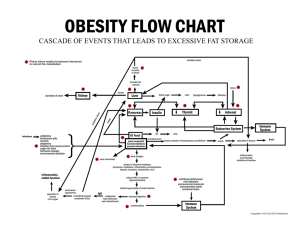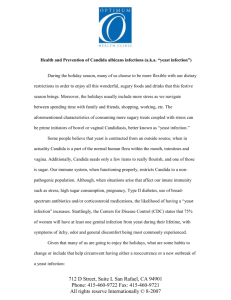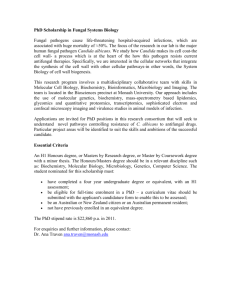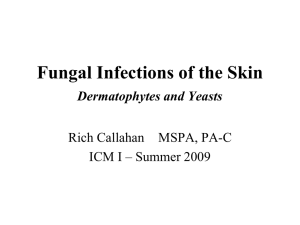Fungal biology Fungal Infections • Eukaryotic (organized nucleus and cell structure)
advertisement
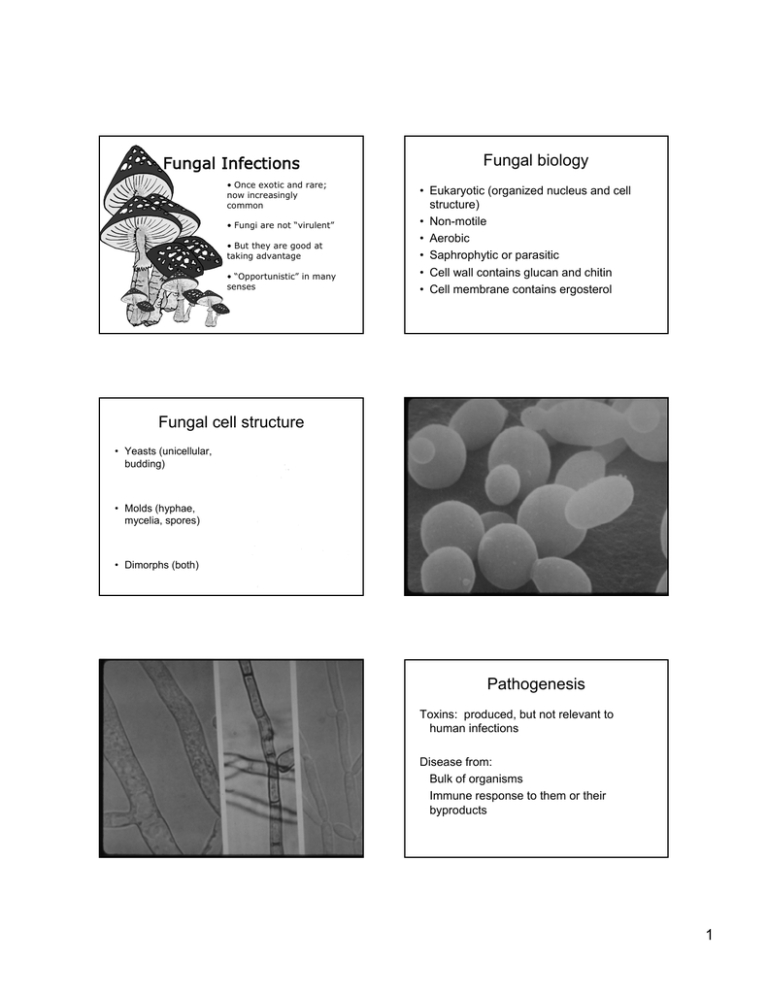
Fungal Infections • Once exotic and rare; now increasingly common • Fungi are not “virulent” • But they are good at taking advantage • “Opportunistic” in many senses Fungal biology • Eukaryotic (organized nucleus and cell structure) • Non-motile • Aerobic • Saphrophytic or parasitic • Cell wall contains glucan and chitin • Cell membrane contains ergosterol Fungal cell structure • Yeasts (unicellular, budding) • Molds (hyphae, mycelia, spores) • Dimorphs (both) Pathogenesis Toxins: produced, but not relevant to human infections Disease from: Bulk of organisms Immune response to them or their byproducts 1 Overview of fungal infections • Superficial or cutaneous (skin, hair, nails) • Subcutaneous • Systemic – “true pathogens” may cause disease in normal hosts although worse with immunocompromise – “opportunists” cause disease almost exclusively in immunocompromised hosts Superficial fungal infections Dermatophytes: molds producing keratinase Pathogenesis: grow as saprophytes on skin/nails; cause inflammation below Clinical: • Tinea corporis Tinea cruris • Tinea pedis Tinea unguum • Tinea capitis 2 Superficial fungal infections Malassezia furfur: lipophilic yeast (derives nourishment from skin lipids) Pathogenesis: lives on skin, causes pigment changes and itch underneath Diseases: • Tinea versicolor • Occasionally fungemia with lipid infusion 3 Subcutaneous fungal infections • Pathogenesis: introduced through skin by foreign body, grow in subcutaneous tissues, spread via lymphatics • Disease; usual local; may disseminate to adjacent bones, joints. • Most common in nonindustrialized world (mycetoma of feet) Subcutaneous fungal infection: Sporotrichosis • Organism: Sporothrix schenkii – Dimorphic soil fungus (mold in environment, yeast in body) • Habitat: soil, worldwide • Pathogenesis: splinters or thorns inoculate organism into subcutaneous tissues 4 Sporotrichosis Pathophysiology: • Spore inoculated by foreign body • Yeasts travel along lymphatics • Elicit mixed pyogenicgranulomatous reaction Clinical: • Gardeners and outdoorspersons • Ulcerating nodules along hard cord • Bone and joint destruction • Dissemination rare 5 Systemic fungal infections: the “true pathogens” Histoplasmosis, Coccidioidomycosis, Blastomycosis • Dimorphic • Respiratory acquisition • Restricted geographic distribution • Infect normal hosts • Disease reminiscent of TB Histoplasmosis Organism: Histoplasma capsulatum – Soil dimorph (yeast in body, mold in environment) Habitat: soils with high N content – Ohio-Mississippi valley; Caribbean; Central and S. America – Guano of bats, birds, poultry (chicken coops and caves Pathogenesis: inhalation of spores Histoplasmosis Pathophysiology: • Mold spores transform into yeast in lung, elicit cellular immunity as per TB • Hematogenous dissemination • Skin test reactivity • Walled off granulomata Clinical: Mimics TB. Usually latent disease, but • may cause acute/chronic cavitary lung disease • may disseminate after infection (infancy, immunocompromise) • may reactivate years later 6 7 Coccidioidomycosis Organism: Coccidioides immitis – Dimorph: mold in soil, spherules and endospores in host Habitat: lower Sonoral life zone (arid): Southwest US, Mexico, Central and South America Pathogenesis: inhalation of spores Cocci Pathophysiology: • Spores transform into spherules in lung, elicit cellular immunity as per TB • Hematogenous dissemination • Skin test reactivity • Walled off granulomas Clinical: • Acute self-limited flu-like seroconversion syndrome (“Valley fever”) • Acute or chronic lung disease • Dissemination (pregnancy, dark skin, immunocompromise) – Skin – Bone – CNS 8 Blastomycosis Organism: Blastomyces dermatiditis dimorph: mold to yeast Habitat: humid woodlands – MidAtlantic zone – Beaver dams, peanut farms – Organic debris rather than soil Pathogenesis: inhalation of spores 9 Blastomycosis Pathophysiology: • Spores transform into yeast in lung, disseminate • No good antigen test to define exposed population Clinical: • Acute or chronic lung disease (nodular/cavitary) • Disseminated disease: – Skin – Bone – Urinary tract in men 10 Systemic fungal infections: B. “the opportunists” Histo, Blasto, Cocci • Geographic distribution • Dimorphic • Infection by inhalation • Pyogenic/granulomatous host response • Similar to TB • Infection =~ immunity Opportunists • Omnipresent • Yeasts or molds • Various routes of infection • Host response varies • Clinical syndromes vary • No lasting immunity Cryptococcosis Organism: Cryptococcus neoformans yeast with a thick polysaccharide capsule Habitat: bioterrorists (of a sort), worldwide Pathogenesis: inhalation of yeasts 11 Cryptococcosis Pathophysiology: • Inhalation leads to • Transient colonization OR • Acute/chronic lung disease OR • CNS invasion Clinical • Pneumonia OR • Meningoencephalitis • Acute or chronic • Fever, headache, stiff neck, fever, delirium • Hydrocephalus 12 Cryptococcal meningitis • India ink preparation of CSF may show organisms • Serum or CSF antigen assay diagnostic in >95% cases of CNS disease Candidiasis • Organism: Candida albicans et al (yeasts with hyphal forms) • Habitat: normal human flora • Pathogenesis: – Colonized areas: change in environment leads to overgrowth – Noncolonized areas: change in immunity leads to invasion 13 Pathogenesis of Candida infections • Primary host defenses: – Intact skin – Intact mucosa with normal pH and normal flora – Functioning lymphocytes – Functioning neutrophils Pathogenesis of local Candida infections • Environmental changes – Wet skin – Changes in local flora – Hormones, foreign bodies • Lymphocyte dysfunction – Immaturity – Destruction (HIV) 14 Pathogenesis of invasive Candida infections • Breach in anatomic integrity (often biofilm on catheter) • Defective PML function (first line of defense) – Myeloperoxidase, complement necessary but not sufficient defense – Cytokines also essential for recruiting phagocytes in disseminated disease – Antibody may or may not be present; may or may not be protective Invasive candidiasis • Usually in critically ill patients with multiple risks (hospitalized, neutropenic, on antibiotics, many catheters) • Fever, leukocytosis, organ dysfunction • Microabscesses in kidney, liver, skin, eye, lung, heart • Candida endocarditis 15 “Virulence” of Candida? • Inherent “virulence” – environmental tolerance – Secrete hydrolases, beta proteases, phospholipases – Can adhere to plastic – Can invade GI, renal epithelium • Additional hyphal virulence – Protects against phagocytosis – Knockout strains Additional comments on candidiasis • Gram stain may help identify • Infection and colonization are difficult to distinguish • Best treatment restores missing defense Aspergillosis • Organism: Aspergillus fumigatus and others – Mold without a yeast phase • Habitat: everywhere, worldwide • Pathogenesis: inhalation of spores Aspergillosis Pathophysiology Spores in lung may: – Elicit allergy – Grow in preexisting cavity – Invade vasculature, disseminate with local and distant disease – Neutrophils prime defenders Clinical • Allergic bronchopulmonary aspergillosis • Aspergilloma • Invasive aspergillosis with pneumonia, other end-organ disease 16 Mucormycosis • Organism: species of Mucorales, genera Rhizopus and Mucor (Zygomycetes) – Molds without a yeast phase • Habitat: everywhere, worldwide • Pathogenesis: inhalation of spores 17 Mucormycosis Pathophysiology: Alveolar MPH/PML clear organisms, BUT: • Metabolic acidosis • Diabetes • Neutrophil dysfunction • Iron overload May enable relentless growth Clinical: The most acute and fulminant fungal infection known Lower airways: pneumonia progressing to infarction Upper airways: sinusitis progressing to brain abscess 18 Summary: Fungal “opportunism” • Metabolic (dermatophytes, M. furfur, mucor) • Dimorphism (sporo, histo, blasto, cocci) • Capsule (cryptococcus) • Adherence (candida) 19 Summary: antifungal defenses • Intact skin (dermatophytes, Candida) • Lymphocyte function (dimorphs, cryptococcus, candida) • Neutrophil function (candida, aspergillus, mucor) • Body milieu (candida, mucor) 20
